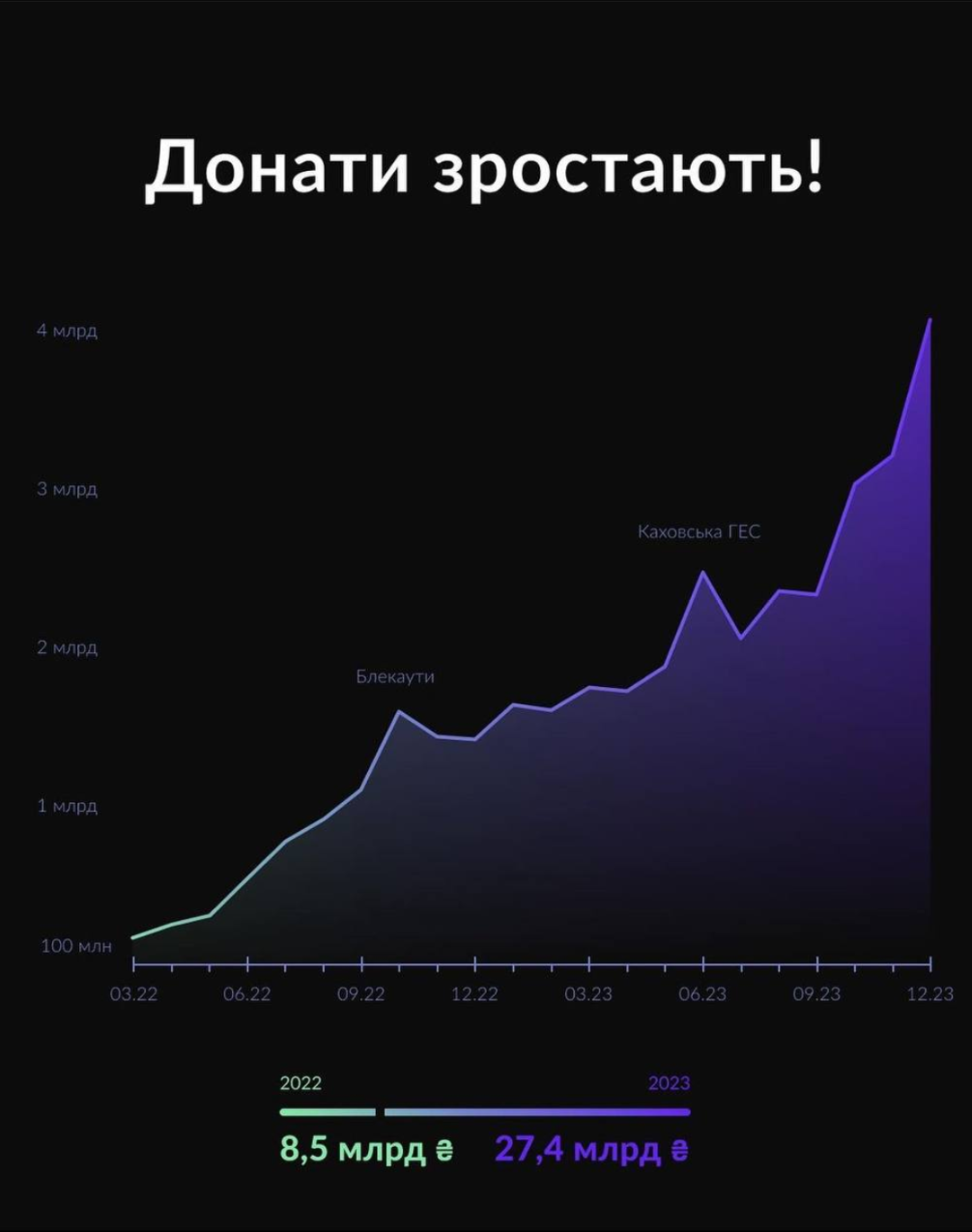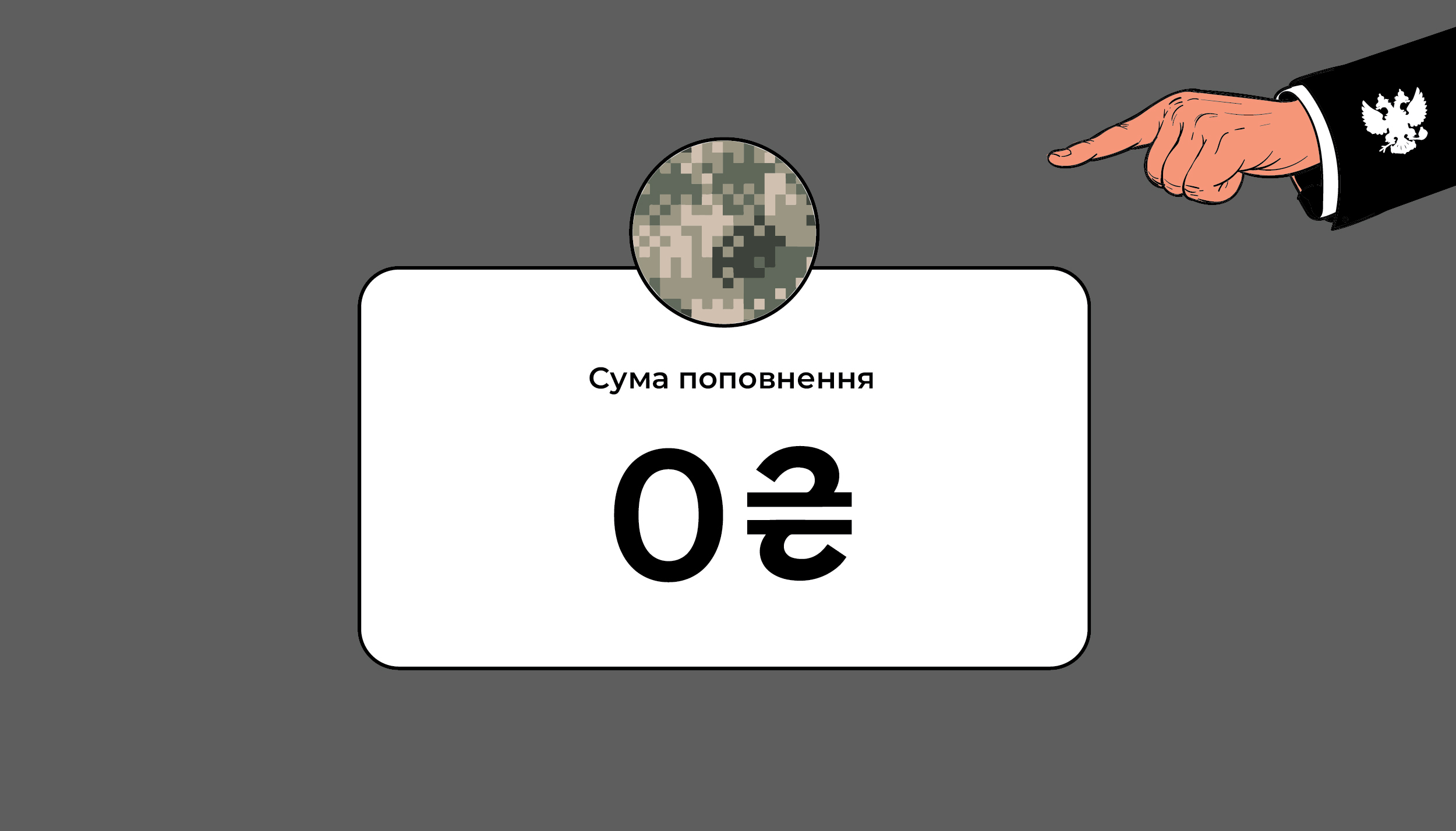Українською читайте тут.
Russian messages aim to convince Ukrainians of their own fatigue, although they continue to donate.
In 2024, Ukraine ranked in the top ten of the Charities Aid Foundation (CAF) World Giving Index, holding the seventh position. Although Ukraine dropped five positions compared to 2023, it remains among the top five countries whose charity ratings have grown the most over the last decade. In February this year, Monobank founder Oleg Gorokhovsky released statistics showing that since the full-scale invasion, €1 billion has been raised through donation platforms. According to the bank’s data from last year, the total sum of donations in 2023 increased compared to 2022: the average donation was 349 UAH instead of 258, and 24.7 billion UAH was raised, compared to 8.5 billion. Contributions through this bank grew by more than 30%. However, it's important to note that in 2023, the donation data covers the entire calendar year, while in 2022, it starts only from March. There is no data for 2024 yet.
There is also information from Ukraine's largest charitable foundations. For example, by October 2024, the "Come Back Alive" foundation had raised about 3 billion UAH, compared to 4.5 billion UAH for the entire calendar year of 2023 and 5.7 billion UAH in 2022. As for Serhiy Prytula's foundation, it raised 2.1 billion UAH in 2023, while during the first year of the full-scale war, it collected over 4 billion UAH.
Donations are not limited to Ukrainians. For example, the largest amount of donations in 2023 was collected by the English-language platform United24 — over 7.9 billion UAH, which accounts for 63% of the total contributions for the year among the two largest Ukrainian funds. There is also no data yet for 2024.
As we can see, the information is incomplete. Various platforms collect donations involving different financial institutions, organizations, and businesses, making it difficult to draw conclusions based on the data from two funds and one bank.
Despite this, Kremlin propagandists are trying in every possible way to discredit the initiative of Ukrainians, claiming they are "tired" or "bored" of donating. Some mock the fundraising efforts, while others accuse those organizing the collections of corruption and money laundering. In other words, they are trying to sow distrust among Ukrainians towards themselves. Detector Media explains how Ukrainians continue to donate, whether the donation rates have indeed "decreased," and why the Russians are speculating on money.
How Ukrainians donate
There are many reasons for charitable giving. Researchers explain that common challenges bring social groups closer and that "charity can be contagious." People find it important to feel part of a noble cause. It is no coincidence that Ukraine's charity level increased during the full-scale war. A survey conducted by the "Rating" Sociological Group in 2023 showed that 63% of Ukrainians have close friends or relatives who have fought or are fighting on the frontlines since February 24, 2022 (the survey sample included 1,000 respondents). This means the war affects most people, and it is understandable that they are involved in providing assistance.
Leaders of Ukraine's major charitable foundations also explain that donations are an emotional matter, with highs and lows. For example, Serhiy Prytula mentioned this. In the fall of 2023, he said the "trends were frankly terrible." But by December of that year, he noted that a "miracle happened," and donations were back on track.
In general, this is a normal phenomenon in charity. Most contributions come after heavy attacks, victories on the front, or other significant events. For example, the infographic of private donations from Monobank in 2023 illustrates this trend:

Infographics – Monobank’s Instagram
Spikes in donations are linked to specific events related to the Russian-Ukrainian war, particularly during blackouts, the breach of the Kakhovka dam, and similar incidents. This infographic reflects the situation in one Ukrainian bank, among many others. However, Oleh Karpenko, Deputy Director of the "Come Back Alive" charitable foundation, agrees with this observation. He notes that increased financial support activity is usually observed after Russia's large-scale attacks on cities and, on the other hand, following "minor Ukrainian victories," such as strikes on enemy territory or the destruction of Russian command posts, aircraft, and ships.
For example, after Russian missiles destroyed the "Okhmatdyt" children's hospital in Kyiv on July 8, 2024, 1 billion UAH was raised by August, as reported by Health Minister Viktor Lyashko.
At that time, Russians attempted to discredit the Ukrainian fundraising for "Okhmatdyt." They claimed that Monobank had started raising funds for the hospital before the Russian missile attack. Anonymous Telegram channels gave various start dates for the collection: some mentioned July 5, others July 7. In reality, Monobank, in collaboration with President Zelenskyy's United24 initiative, opened the fundraiser for 100 million UAH for the children's hospital on July 8. Various businesses and governments joined the efforts and announced it on the same day. Other Ukrainian banks (the complete list can be found here), such as PUMB, Otpbank, and PrivatBank, also participated.
The propagandists not only tried to suggest that the hospital attack was staged but also attempted to convince people that banks, in collaboration with Ukrainian authorities, "conspired" to extract money from the public. After all, they argued that if the attack was "staged," then the funds would certainly "not reach" their intended destination.
In this case, the propagandists employed a classic tactic of devaluation. They deliberately downplayed the significance, effectiveness, or success of certain events, decisions, or processes.
How propaganda discredits fundraising
As early as 2022, Detector Media analysts from the Detector Research Center have identified several fake charity websites that claim to raise funds "in support" of the Ukrainian army. One example is a counterfeit version of the "Come Back Alive" foundation's website. Russians copied the website's appearance, used accurate information about the foundation raising over $100 million for the Ukrainian army, translated it, and attributed this to "Russian volunteers." In the fake version, all donations allegedly went to the occupation army. Essentially, they mirror the actions of Ukrainians, a typical tactic of Russian propaganda.
Incidentally, the Russian charity fund "Potribna Dopomoha" (Need Help), which was labeled a "foreign agent" in Russia, and the Tiburon Research online survey agency conducted their own social survey on charity and donations. Their results showed that about half of respondents (43% in 2023) do not understand the difference between the work of charitable organizations and government bodies. They also found that only 18% of respondents "donate to the Russian front." The information was gathered through online surveys of 1,200 Russian respondents from various regions.
Additionally, propagandists discredit the Ukrainian initiative by manipulating economic issues. For example, they focus on the rise of tariffs and energy costs in Ukraine, leading to higher living expenses. As a result, they claim that Ukrainians are no longer able to donate. One of the numerous fake stories spread by anonymous Telegram channels involved allegations that the Ukrainian Armed Forces are engaged in "sexual exploitation" of women. According to the false story, the command of the 44th Separate Mechanized Brigade allegedly forced female soldiers to raise funds for the brigade using explicit photos, as "Ukrainians have long stopped donating."
Another common propagandist narrative is the alleged misuse of donations or that fundraising is a scam. For instance, fake reports claimed that Serhiy Prytula’s foundation inflated the price of an armored personnel carrier (APC) by 2.5 times during one of its campaigns.
However, after receiving a comment from the organization, it was revealed that the high cost of the APCs was due to several factors, including the place of purchase (the UK), their technical condition, availability, and logistics. The need for these specific vehicles was also coordinated with the military.
Earlier, propagandists spread stories that Ukrainian volunteers were "shamelessly raising money" during Russian attacks, profiting from human suffering, and trying to convince people that donating to the Armed Forces of Ukraine or helping volunteers was pointless since the funds wouldn’t go where they were intended.
Pro-Russian blogger Anatoliy Shariy also discredits the work of the "Come Back Alive" foundation and Serhiy Prytula’s foundation. Every fundraising campaign for the Ukrainian army announced by these organizations faces criticism on his Telegram channel. Shariy claims that volunteers are frauds who "forget" to purchase the items they promised during the fundraising. He refers to those who donate to Prytula and Sternenko as "village hens," suggesting that only the ignorant believe that private individuals like Prytula or Sternenko can buy Bayraktars or other goods. The propagandist also spreads the idea that Ukrainian volunteers operate through shell companies and launder funds. However, both the "Come Back Alive" Foundation and Serhiy Prytula's Foundation regularly report on their activities on social media, where anyone can verify their work.
By the way, information on how to donate to Shariy's accounts can be found on both his Telegram and YouTube channels. Allegedly, the funds he collects, in addition to supposed Russian donations, are spent on helping Ukrainians. However, there is no reliable information about the amount of donations collected or their intended use.
Of course, actual cases of fraud involving donations exist. For example, the volunteer medical battalion "Hospitallers" recently reported the results of an internal investigation into a former employee, 30-year-old Anna Skolbushevska. For about six months, she collected money supposedly for her crew's needs but spent it on travel and gambling. The military has referred the case to law enforcement regarding the embezzlement of funds. The "Hospitallers" urged people to donate only to the fund's account or to individuals' bank cards listed on the official battalion website.
To protect people from such cases, the Ministry of Digital Transformation of Ukraine has created an educational series on how to donate correctly. It teaches how to verify charities and volunteers using open-source searches.
Nevertheless, propaganda often resorts to generalizations, attempting to convince the audience that almost every volunteer organization is "laundering money." This approach aims to undermine trust in volunteer organizations and reduce support for the Ukrainian Armed Forces.
And what is the outcome? Ukrainians continue to donate. Like any charitable activity, there are periods when public engagement decreases or increases. These fluctuations and their patterns are confirmed not only by current statistics from the foundations but also by historical data. For example, in 2017, Olha Syrtsova, an associate professor at Zaporizhzhya National University, compared surges in military aid by residents of the modern Zaporizhzhya region in 1914–1916 and 2014–2016.
"A common feature of both periods is the lack of pre-planned state logistics for providing medical care to wounded soldiers. Therefore, there was a need to organize military hospitals through the initiatives of charitable organizations," writes Olha Syrtsova.
Gradually, by 1916 and 2016, the states were able to address the issues of aiding refugees and wounded soldiers, and in both cases, the involvement of volunteers and benefactors decreased. The Ukrainian volunteer movement is now in a new phase that began in 2022, but there is still not enough comprehensive data to prove an increase, decrease, or consistency in donations.
However, Russian propagandists try to influence Ukrainian sentiments by showing that "everything is bad" and "there is no support for the army." Yet, based on current indicators, these generalizations are either fake or attempt to manipulate information about fluctuations in donations or support for Ukraine's Defense Forces.
Main page illustration credits: Natalia Lobach



